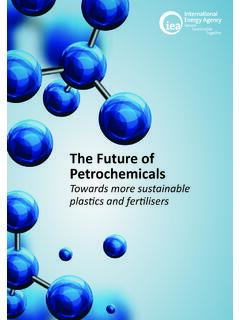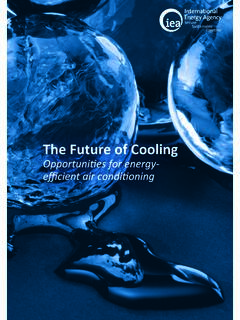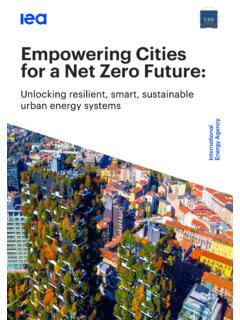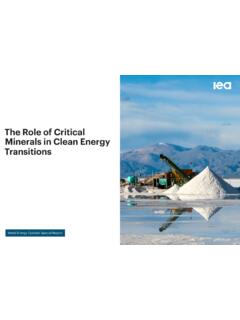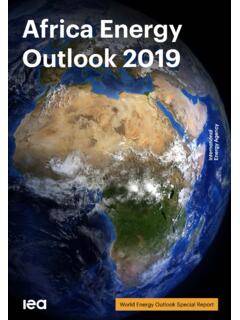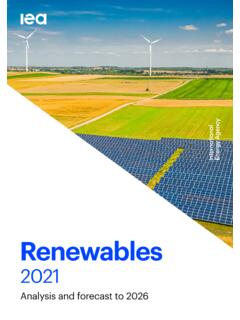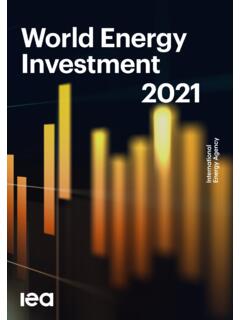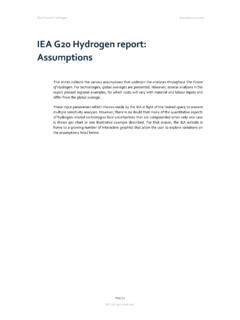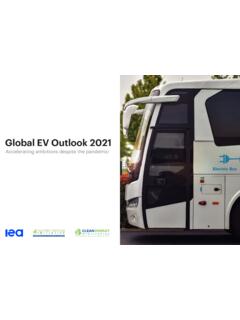Transcription of Canada 2022 - Energy Policy Review
1 Canada 2022. Energy Policy Review INTERNATIONAL Energy . AGENCY. The IEA examines the IEA member IEA association full spectrum countries: countries: of Energy issues including oil, gas and Australia Brazil coal supply and Austria China demand, renewable Belgium India Energy technologies, Canada Indonesia electricity markets, Czech Republic Morocco Energy efficiency, Denmark Singapore access to Energy , Estonia South Africa demand side Finland Thailand management and France much more. Through Germany its work, the IEA. Greece advocates policies Hungary that will enhance the reliability, affordability Ireland and sustainability of Italy Energy in its Japan 30 member countries, Korea 8 association Luxembourg countries and beyond. Mexico Netherlands New Zealand Norway Poland Portugal Please note that this Slovak Republic publication is subject to Spain specific restrictions that limit Sweden its use and distribution. The terms and conditions are Switzerland available online at Turkey United Kingdom United States This publication and any The European map included herein are without prejudice to the Commission also status of or sovereignty over participates in the any territory, to the work of the IEA.
2 Delimitation of international frontiers and boundaries and to the name of any territory, city or area. Source: IEA. All rights reserved. International Energy Agency Website: Foreword FOREWORDS. The International Energy Agency (IEA) has conducted in-depth peer reviews of its member countries' Energy policies since 1976. This process supports Energy Policy development and encourages the exchange of and learning from international best practices. By seeing what has worked or not in the real world , these reviews help to identify policies that deliver concrete results. Since the last IEA in-depth Review in 2015, Canada has made a series of international and domestic commitments, putting the country on a path towards an ambitious transformation of its Energy system, while remaining a stable and reliable supplier of Energy to the world. Most recently, Canada set a target to cut greenhouse gas emissions by 40-45% from 2005. levels by 2030 and legislated a commitment to reach net zero emissions by 2050.
3 I am especially grateful to Canada 's Minister of Natural Resources, Jonathan Wilkinson, for his leadership on Energy and climate issues and his support for key IEA initiatives, including in his previous role as Minister of Environment and Climate Change. In particular, I was impressed by the leadership shown by Canada at COP26. This came through in its more ambitious targets for cutting carbon emissions and its participation in the Global Methane Pledge, which was underlined by Canada 's commendable commitment to reduce methane emissions from oil and gas operations by 75% by 2030, as recommended in recent IEA analysis. Notably, Canada has promoted a people-centred approach to its clean Energy transition, including initiatives to promote gender equity in clean Energy sectors;. programmes to increase access to clean Energy in northern, remote and Indigenous communities; and actions to enable just transitions for fossil fuel workers. Achieving Canada 's enhanced targets presents both challenges and opportunities given the country's profile as a major producer, consumer and exporter of Energy .
4 Moreover, its highly decentralised system of government means coordination among federal, provincial and territorial governments is essential for a successful Energy transition. Canada has a number of Policy measures in place to support its Energy and climate targets, including an ambitious carbon-pricing scheme, clean fuel regulations, a commitment to phase out unabated coal use by 2030, nuclear plant extensions, upstream methane regulations, Energy efficiency programmes and measures to decarbonise the transport sector. Canada 's electricity supply is among the cleanest in the world, thanks in large part to the dominance of hydro power and the important role of nuclear . Greater interconnections among provinces and territories can ensure balanced progress towards national goals for decarbonising the power sector. Steeper emissions reductions are still needed in other sectors, notably oil and gas production, transport and industry. To this end, Canada has focused its efforts on a number of technologies, including carbon capture, utilisation and storage; hydrogen; and small modular nuclear reactors, with a view to serving as a supplier of Energy and climate solutions to the world.
5 I sincerely hope that the recommendations proposed in this report will help Canada navigate its Energy system transformation and pathway to net zero by 2050. Dr. Fatih Birol IEA. All rights reserved. Executive Director International Energy Agency 3. FOREWORDS. Foreword The twin crises of climate change and biodiversity loss pose enormous threats to long- term global security and economic well-being around the world. Canada , alongside others in the international community, must rapidly reduce carbon emissions to fight climate change and seize the significant economic opportunities presented for businesses, communities and workers. As Canada 's Minister of Natural Resources, I am very pleased to welcome the International Energy Agency's (IEA) Review of Canada 's approach to building a clean Energy future. This report acknowledges our ambitious efforts and historic investments to develop pathways to achieve net-zero emissions by 2050 and ensure a transition that aligns with our objective of limiting global warming to degrees Celsius.
6 These pathways will drive inclusive economic prosperity for our workers while yielding technology, products and know-how that can be exported and applied around the world. Canada is blessed with an abundance of natural resources that position us to be a global leader in clean Energy . We also have a skilled workforce and innovative organizations at the helm of the transition, with 12 Canadian companies featured in the 2020 Global Cleantech 100 and Indigenous leaders across the country building and operating renewable Energy projects for their communities. The key to Canada 's clean Energy future will be empowering our workers to harness Canada 's vast resources in ways that make sense environmentally and economically for their region and that's exactly what our government is doing. We have committed more than $100 billion toward climate action and clean growth since 2015, including major investments in clean power, Energy efficiency, industrial decarbonization, clean technology and transportation.
7 We also have a world-leading price on pollution and action plans for promising technologies like hydrogen and small modular reactors. All of this is intended to ensure that emissions go down at a pace and on a scale aligned with our degree Celsius targets but more must be done. That's why our government recently committed to new measures to accelerate the clean Energy transition, including: requiring the oil and gas sector to be net-zero by 2050 and setting interim five-year targets;. requiring oil and gas companies to reduce methane emissions by at least 75 percent below 2012. levels by 2030;. creating a 100-percent net-zero electricity system by 2035; and providing support for domestic procurement of Canadian clean technology. As this report recognizes, Canada 's Energy policies, programs and investments align with our ambitious climate goals. We believe that we can achieve our targets while creating good jobs, a stronger economy and a more inclusive future for all regions of the country.
8 Of course, for any nation to succeed in the fight against climate change, we must all succeed. Canada is working with our partners to support a truly global transition and build on the momentum from COP26. I am proud of the progress that Canada has made in the last six years, and I believe the future is bright. I thank the IEA for the work it does to help governments build a clean Energy future and, specifically, for this report. IEA. All rights reserved. The Honourable Jonathan Wilkinson Canada 's Minister of Natural Resources 4. TABLE OF CONTENTS. Energy INSIGHTS. Forewords ..3. 1. Executive summary ..11. Overview ..11. Climate change plans and targets ..12. Carbon pricing ..13. Electricity Decarbonising upstream oil and gas production ..13. Energy efficiency ..14. Clean fuels ..15. Technology and innovation ..15. People-centred Energy transitions ..16. Key recommendations ..17. 2. General Energy Policy ..19. Country overview ..19. Energy supply and Energy projections.
9 26. Institutional overview ..27. Energy and climate Policy overview ..31. Assessment ..45. Energy TRANSITION. 3. Energy and climate change ..53. Overview ..53. Energy -related CO2 emissions ..54. CO2 emissions drivers and carbon intensity ..55. Emissions targets and Policy ..57. Climate Climate financing ..74. Assessment ..75. IEA. All rights reserved. 5. TABLE OF CONTENTS. 4. Energy efficiency ..83. Overview ..83. Energy demand by sector ..84. Energy efficiency targets and policies ..88. International collaboration .. 105. Assessment .. 105. 110. 5. Renewable Energy .. 113. Overview .. 113. Renewable Energy supply .. 115. Renewable Energy policies .. 117. Assessment .. 127. 131. 6. Energy research, development and innovation .. 133. Overview .. 133. Energy innovation priorities and guiding documents .. 136. Key actors in Canada 's Energy innovation ecosystem .. 137. Resource push .. 138. Knowledge 143. Market pull .. 144. Socio-political support .. 145. Monitoring, evaluation and tracking of 146.
10 Assessment .. 146. 148. Energy SECURITY. 7. 151. Overview .. 151. Electricity supply and 152. Electricity trade .. 153. Electricity demand .. 154. Market structure .. 155. Electricity market regulation .. 156. IEA. All rights reserved. Interconnections .. 157. Retail prices and taxes .. 160. 6. TABLE OF CONTENTS. Electricity Policy .. 161. TABLE OF CONTENTS. Electricity security .. 170. Assessment .. 172. 176. Annex Provincial electricity systems .. 177. 8. 181. Overview .. 181. nuclear Policy overview .. 182. CANDU refurbishments and nuclear new 184. SMR Roadmap and Action 185. nuclear regulation .. 187. Uranium and nuclear fuel .. 189. nuclear waste management and decommissioning .. 190. nuclear research and development and radioisotopes production .. 191. Assessment .. 192. 196. 9. Coal .. 199. Overview .. 199. Supply and 199. Coal Policy .. 202. Assessment .. 205. 207. 10. Natural gas .. 209. Overview .. 209. Supply and 210. Retail prices and taxation .. 213. 215.
